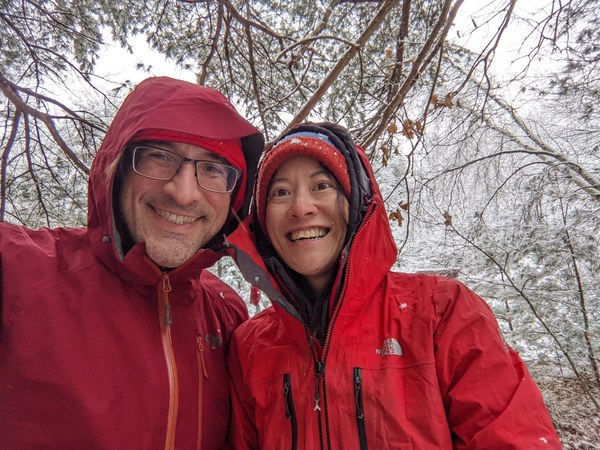
The outdoors has always been a source of inspiration and rejuvenation. It presents an opportunity to forge deep connections with nature, push our boundaries, and craft lasting memories. At The Mountaineers, we believe all people should have equitable access to the outdoors and the transformative benefits it provides. Through our volunteer-led programs, we strive to empower our members and foster a culture of belonging by providing outdoor skills education to individuals from all backgrounds.
Supporting our organization's leaders is essential to promoting an inclusive outdoors and offering outdoor education that feels accessible for people of all backgrounds and abilities. Each year, thousands of dedicated volunteers lead every aspect of our organization. They embody the spirit of giving back, devoting their time and expertise to support committees, organize trips, teach courses, and manage important behind-the-scenes tasks year after year. Motivated by the growing requests from our volunteers for guidance in creating inclusive spaces during their activities, a working group of Mountaineers volunteer leaders from across branches and activities created The Mountaineers Equity & Inclusion Leader Toolkit.
Developed with support from The Mountaineers Equity & Inclusion Committee, the E&I Leader Toolkit is a rich collection of reading materials, resources, and reflective exercises. The toolkit is one component of The Mountaineers broader strategy to foster equity and belonging within the organization, complementing other efforts such as changing staff hiring processes, updating board policies, improving the scholarships program, and more. The toolkit is not a comprehensive lesson plan on diversity, equity, and inclusion, but rather a carefully curated list of tools and ideas that volunteers can use to create more equitable and inclusive activities. Siana Wong, past Chair of the Equity & Inclusion Committee and one of the creators of the toolkit, explains, “It was built by Mountaineers volunteers for Mountaineers volunteers... Many of the resources and examples are directly what volunteers have asked for, based on volunteers’ and members’ past experiences or what they might encounter in the future. There are specific tools to help leaders plan, execute, and finish their activities with an equity and inclusion perspective.”
Impact and evolution
Designed specifically with a Mountaineers volunteer in mind,
the toolkit encourages volunteer leaders to consider fostering feelings of belonging at every step of the planning and implementation process. Volunteers are emboldened to infuse
their activities with these principles, all without altering their
activity’s core goals.
Siana is especially enthusiastic about the toolkit's comprehensive scope, highlighting it as a tool for volunteers serving in any capacity. “There is a great deal of information
covering inclusive leadership, managing group dynamics, and
addressing conflict and bystander intervention,” she says. “These kinds of topics span across activities, committees, and
branches.” Siana and fellow toolkit creators aspire for it to
become a common resource for all our leaders.
Mountaineers volunteers have the opportunity to bring
about transformative experiences in nature, and the Equity
& Inclusion Leader Toolkit helps facilitate those experiences.
“The more leaders become educated in equity and inclusion,
living it by example and helping to spread this work, the
better we are able to cultivate equity and belonging in our
Mountaineers community,” said Siana. When we equip our Volunteers with the knowledge and tools to embrace equity
and inclusion, they become catalysts toward a rich culture of
belonging within The Mountaineers.
Recognizing the dynamic nature of our organization and the
evolving needs of our community, the toolkit was intentionally
designed to be adaptable – a living resource that will evolve
and grow in step with our organization's progression. “The
toolkit is also meant to be organic, so I hope that just as our
organization must adapt and change to the needs of our
community, so will the toolkit,” said Siana.
In the spirit of shared learning and improvement, volunteers
are encouraged to contribute their experiences, insights, and
success stories to the toolkit. This collaborative approach
allows for an ongoing exchange of knowledge, ensuring that the
toolkit remains relevant and effective to the audience it serves.
 Siana and her husband, Marko Pavela, at the top of Jerimoth Hill, Rhode Island. Photo by Siana Wong.
Siana and her husband, Marko Pavela, at the top of Jerimoth Hill, Rhode Island. Photo by Siana Wong.
Future vision
The Mountaineers Equity & Inclusion Leader Toolkit serves
as a valuable resource, inspiring volunteers to approach their
trips and courses from an equity and belonging perspective.
As an example, volunteers have the ability to decide what
information to put into a trip listing. The Toolkit outlines
different items that should be included to best manage
expectations of participants both before and during the
activity. What is the goal of the trip? What's the anticipated
pace? How does the leader like to make decisions and
manage group dynamics? Spelling out this information helps
potential participants understand what is expected of them
and determine whether or not that trip is a good fit. All of
this fosters a healthy group dynamic before a trip that can
be further strengthened through in-person activities. All of
us do better when we know what is expected of us and what
to expect from an experience. By providing everyone with
the same information, we can level the playing field to make
our activities more accessible and help foster a feeling of
belonging for everyone.
While the toolkit is primarily designed for Mountaineers
volunteers, its usefulness extends to anyone seeking insights and tools in the pursuit of equity and inclusion. The ultimate
intention of the toolkit is clear: the more Mountaineers who
engage with the toolkit and integrate it into their programs,
the greater positive impact we can have on fostering a
community where everyone feels safe in the outdoors.
Key Features of The Mountaineers Equity & Inclusion Leader Toolkit:
Trip and Course Planning: The toolkit provides practical guidance on how to create inclusive experiences for participants of diverse backgrounds and abilities. It offers insights into trip logistics, communication templates, and post-activity considerations for adapting activities to accommodate varying needs.
Language and Communication: Recognizing the power of language, the toolkit provides guidance on incorporating inclusive terminology during an activity or course, such as including time to share pronouns during introductions. It highlights the importance of mindful communication to ensure an equitable experience for all participants.
Recruitment: The toolkit offers ways of engaging with aspiring volunteers to ensure the continuity of our programs. It provides ideas for outreach and developing mentoring opportunities to support continued participation across our activities.
Resource Library: The toolkit includes an extensive collection of resources, readings, and reflection prompts, including sample forms, templates, checklists, and more. Leaders can leverage the content to enhance their own skills facilitating inclusive experiences, growing cultural competence, understanding unconscious biases, and promoting constructive conversations.
A message of gratitude from Siana
"A large thank you goes to the small group of dedicated
volunteers that spent a lot of time discussing and
brainstorming during meetings, attending membership-wide
listening sessions related to equity and inclusion, researching
relevant subject matter, collecting resources, and creating
content in order to build the toolkit. Although not the most
glamorous of work, these contributions are so important
to helping us achieve our goals of cultivating equity and
belonging.”
Access The Mountaineers Equity & Inclusion Leader Toolkit. Want even more resources on fostering experiences
with equity and belonging? Check out our Emotional
Safety in the Outdoors eLearning course.
This article originally appeared in our fall 2023 issue of Mountaineer magazine. To view the original article in magazine form and read more stories from our publication, visit our magazine archive.
 Michelle Song
Michelle Song